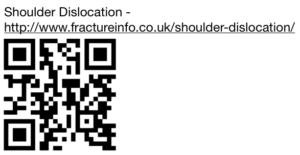What will I expeirence?
It is a disruption of the joint capsule of the major shoulder joint (the glenohumeral joint).
It is caused by a sudden jolt to the shoulder joint, usually in a rugby tackle or heavy fall. The socket of the shoulder joint (glenoid) is quite shallow, so the shoulder is not as stable as other joints like the hip.
If you have dislocated your shoulder you will usually have pain – because of tearing of the joint capsule, there is severe pain when it first occurs.
Repeat dislocations are usually less painful or dramatic.
The shoulder will be stiff when it is dislocated out of the socket, movement is very restricted.
When the doctor looks at your shoulder it will look deformed – there is usually a loss of the usual shape of the shoulder. In very muscular people, the deformity may be hard to see.
Shoulder movement is very restricted.
Occasionally there may be numbness of an area of skin over the shoulder, plus weakness of shoulder movement. This suggests that the axillary nerve around the shoulder has been stretched during the dislocation.
How is it diagnosed?
X-rays can show the dislocation, plus any associated bony injury such as a broken bone (fracture). This can happen at the rim of the socket (glenoid rim fracture or Bankart lesion).
An MRI scan may be ordered to look for injury to the soft tissues in the shoulder, especially if you have dislocated your shoulder more than once. This does not happen immediately as there will be alot of swelling in the tissues around the shoulder following a dislocation.
What will happen?
Reduction of the dislocation should be done as soon as possible, by the best qualified person available.
First time dislocations usually need reduction at an A & E clinic or hospital, but repeat dislocations can often be put back on the sideline.
A sling for comfort for a few weeks provides support and helps ease the pain.
Pain relief with paracetamol or ibuprufen or similar medications.
Once your shoulder in comfortable a series of muscle exercises with a physiotherapist can help restore normal strength and mobility.
The chance of re-dislocation is higher in young athletes playing contact sports like rugby. The decision to have surgery needs to be carefully considered between the patient and their surgeon, and depends on many factors. Any person having surgery needs to commit to a rehabilitation programme lasting several months.
How long will it take to recover?
Recovery time on average is 2-3 months.
Recovery sequence
- Reduction of dislocation.
- Sling and painkillers.
- Once comfrotable start gentle passive exercises.
- As range of movement increases, move onto strengthening and stability exercises using theraband and weights with pulleys.
- Restart gentle contact training when cleared by your physiotherapist or doctor.
- Continue a maintenance exercise programme to keep your rotator cuff muscles strong.
When can I...
Return to work - Light office work can be started as soon as you feel comfortable. It will take several weeks before you are able to return to manual work.
Drive - It is likely to be a few weeks before your shoulder is comfortable enough to be able to perform an emergency swerve. You can return to driving when you are able to do this safely, and without pain.
Exercise - Non contact sports once pain allows. Contact sports as guided by your physiotherapist, usually several weeks / months.
